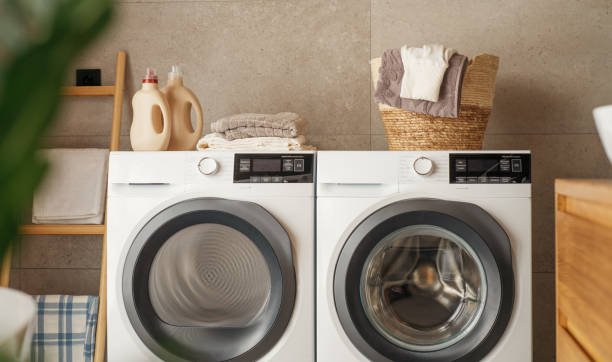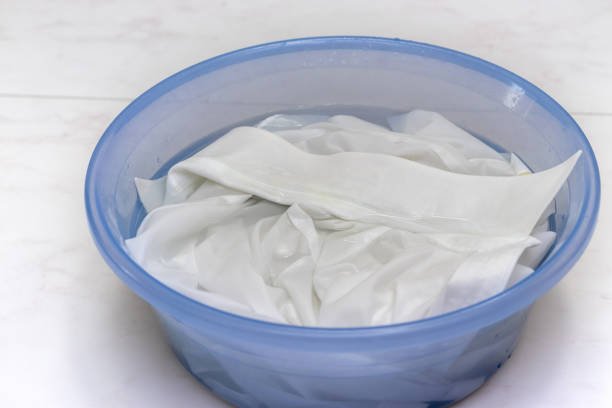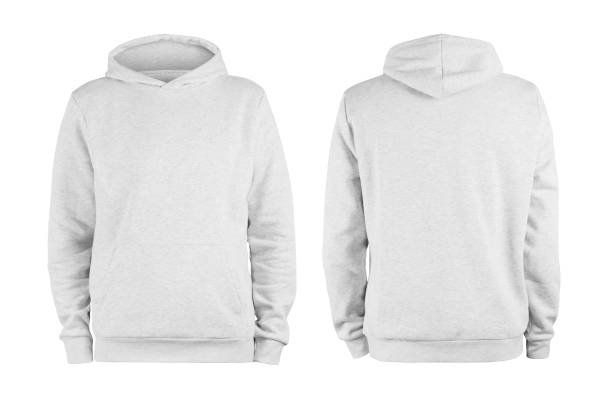Has your white shirt lost its former brilliance, taking on a dull “brownish” or “grayish” hue? If you’re yearning to restore that dazzling white, bleach may be the perfect solution. Bleaching is a quick, straightforward, and cost-effective method that can revitalize various fabrics, bringing back their radiant white appearance.
Over time, white garments are susceptible to stains, sweat marks, and the effects of washing chemicals, which can diminish their brightness and even lead to yellowing. Fortunately, with the right bleaching techniques, you can effectively eliminate these imperfections and restore your clothing to its pristine condition.
So, how can you safely bleach your garments? By mastering the correct methods and techniques, you can remove stubborn stains while protecting the fabric. Whether you opt for a washing machine designed for all types of fabrics or choose a hand-soaking approach, you can achieve optimal results without damaging your clothing.
Continue reading to discover more expert tips on how to bleach white garments and bring them back to life.
3 Best Ways to Bleach White Clothes

How to wash white clothes with bleach? By soaking them in a pail of cold water, adding bleach, and letting them sit for ten minutes or so, you can use bleach for white clothes. Then, remove the items, rinse them in cold water, and spread them out to dry. To enhance comprehension, the best way to bleach white clothes is:
How to Use Bleach to Clean White Clothing
Bleach is a powerful cleaning agent that can quickly restore the brightness of white garments. When used correctly, it effectively removes stains and eliminates yellowing, making clothes look brand new. Here are detailed steps to help you bleach white clothing efficiently and professionally:
1. Prepare the Bleach Soaking Solution
Choose a Container:
First, select a sufficiently large container, such as a bucket, basin, or washing machine, to allow the garments to soak freely and move around. Ensure the container is clean to avoid dirt affecting the bleaching process.
Add Cold Water:
Fill the container with enough cold water to ensure the garments are fully submerged by several inches. Generally, using one gallon of cold water is suitable.
2. Add Bleach
Follow the Instructions on the Label:
According to the bleach product’s instructions, add the appropriate amount of bleach. For regular bleaching, typically add 1/4 cup of bleach per gallon of water. If you’re bleaching multiple items, you may increase the bleach quantity, but always adhere to the product’s recommendations.
Mix Thoroughly:
Gently stir the mixture of water and bleach to ensure an even distribution of bleach throughout the liquid for optimal bleaching results.
3. Soak the Garments
Submerge the Clothing:
Carefully place the white clothing items into the bleach solution. Ensure the garments are completely submerged in the liquid.
Control Soaking Time:
Allow the clothes to soak for 5 to 10 minutes. During this time, you can gently stir the items to ensure that every part is evenly exposed to the bleach solution. Be mindful not to soak for too long, as prolonged exposure to bleach can damage the fabric.
4. Rinse the Clothing
Remove the Garments:
After the soaking time is up, immediately take the garments out and rinse thoroughly with cold water to remove bleach and any residues. This step is crucial to prevent potential irritation to the fabric and skin.
Ensure Thorough Rinsing:
While rinsing, make sure the water flows through every corner of the garments to avoid any remaining bleach, which could lead to yellow stains or odors.
5. Dry the Clothing
Wring Out Excess Water:
After rinsing, gently wring out the clothing to remove excess moisture. You can use a clean towel to pat them dry or use the spin cycle of the washing machine.
Choose the Right Drying Method:
Hang the clothes to dry, preferably in sunlight, as this not only helps eliminate residual odors but also utilizes the sun’s natural bleaching effect to enhance whiteness. If using a dryer, select a low heat setting to protect the fabric.
How to Safely Bleach White Clothes Using a Washing Machine

To maintain the pristine appearance of your white garments, using bleach is an effective solution. Whether it’s towels or cloth diapers, bleach can help disinfect and brighten fibers. However, it’s essential to follow proper procedures and guidelines when using bleach in a washing machine to avoid damaging your clothing.
1. Select the Right Bleach
The first step in bleaching white clothes is choosing the appropriate type of bleach. Chlorine bleach is the most commonly used for white textiles; however, it can be harsh and potentially damaging if misused. Non-chlorine bleach, or oxygen bleach, is a gentler alternative that can effectively brighten fabrics without the same level of risk. Always read the instructions on the bleach bottle to ensure it is suitable for the fabrics you plan to treat.
2. Sort Your Laundry
Before you begin bleaching, sort your laundry into white and colored items. This prevents any color bleeding that could occur from colored fabrics transferring dye to whites. Check the care labels on your garments to confirm that they are bleach-safe. If a label indicates “do not bleach,” it’s best to avoid using bleach on that item.
3. Dilute the Bleach
To minimize the risk of damaging your fabrics, it’s crucial to dilute bleach before use. For chlorine bleach, mix one part bleach with four parts water. For non-chlorine bleach, the dilution ratio is one part bleach to ten parts water. This step ensures a more even distribution of the bleach and reduces the concentration that comes into direct contact with the fabric.
4. Load the Washing Machine
Once your bleach is diluted, it’s time to load the washing machine. Start by adding the diluted bleach solution into the bleach dispenser or directly into the wash drum, depending on your machine’s design. Next, place the sorted white garments into the washing machine.
5. Choose the Appropriate Cycle
Selecting the correct wash cycle is essential for effective bleaching. For chlorine bleach, opt for the longest wash cycle with the hottest water setting to maximize the cleaning power. If you are using non-chlorine bleach, choose a shorter wash cycle with the hottest water that is safe for the fabrics.
6. Ensure Thorough Rinsing
After the washing cycle is complete, it’s vital to thoroughly rinse the garments to remove any remaining bleach residue. This helps to prevent any potential fabric damage or skin irritation that could occur from residual chemicals.
7. Dry the Clothes Properly
The final step involves drying your clothes correctly. For garments treated with chlorine bleach, use the lowest heat setting on the dryer to avoid any damage. If using non-chlorine bleach, allow the clothes to air dry. Sun-drying can also help enhance the whiteness of your clothes due to the natural bleaching properties of sunlight.
By following these detailed steps, you can safely bleach white clothes in your washing machine without risking damage to the fabric. Always remember to read both the care labels on your garments and the instructions on the bleach bottle to ensure optimal results. Proper bleaching techniques not only maintain the quality of your garments but also enhance their longevity and appearance. If you have further questions or need expert advice, don’t hesitate to consult Yoplook for the best laundry practices.
Sun Bleaching Method: How to Effectively Brighten White Clothes

Sun bleaching is a natural and eco-friendly way to restore the brightness of your white garments. This method harnesses the sun’s powerful ultraviolet rays to lighten fabrics and remove stains, making it an effective alternative to chemical bleaching agents. Here’s how to do it safely and effectively.
Step 1: Wash Your White Clothes
Begin by washing your white garments as you normally would. This step helps to remove any surface dirt, oils, or stains that could inhibit the bleaching process. Use a high-quality detergent for the best results.
Step 2: Rinse and Prepare for Drying
After washing, thoroughly rinse the clothes to ensure all detergent residues are removed. Then, hang the clothes on a clothesline, drying rack, or a clean, flat surface. Make sure you choose a day that is warm and sunny, without any chance of rain. The brighter the sunlight, the more effective the sun bleaching will be.
Step 3: Drying Time
Allow the clothes to dry outdoors for a few hours. However, avoid leaving them in direct sunlight for extended periods, as prolonged exposure can weaken the fabric fibers, leading to deterioration. Once the garments are dry, promptly bring them back indoors.
Important Safety Tips Before Sun Bleaching
- Check Care Labels: Always verify that your clothing is bleach-safe by checking the care labels. If the label indicates “do not bleach,” using bleach may damage or discolor the fabric.
- Conduct a Spot Test: If there are no care instructions available, perform a spot test by applying a small amount of diluted bleach on an inconspicuous area, such as the inner seam or collar. Wait to see if any discoloration occurs. If there’s no adverse reaction, it should be safe to proceed.
- Be Cautious with Bleach: Bleach is a corrosive substance, and mishandling it can leave marks on your clothes. When using bleach for sun bleaching, ensure that you are aware of its properties and handle it with care.
- Ensure Proper Ventilation: Always work in a well-ventilated area when using bleach. This helps to disperse any fumes that may arise from the bleach application.
- Use the Right Bleach Type: The type of bleach you choose can influence your method. For sun bleaching, a liquid bleach diluted with water is ideal. If treating specific stains, consider using a spray or pen applicator for precise application.
- Protect Your Skin: Wear latex gloves to shield your hands from bleach. A plastic apron can also protect your clothing from accidental spills.
- Avoid Mixing Chemicals: Never mix bleach with ammonia or any other household chemicals, as this can produce harmful gases. Stick to bleach-specific cleaning products for best results.
- Know Your Fabrics: Be cautious when using bleach on delicate materials such as silk, wool, or leather. These fabrics can be sensitive to bleaching agents and may require special care.
- Dilution is Key: Never apply strong bleach directly onto your clothes without dilution. Always follow dilution guidelines to minimize damage.
- Beware of Harmful Reactions: Mixing bleach with vinegar or ammonia can create toxic fumes, which can be harmful to your lungs. Avoid using these substances in conjunction with bleach
By following these detailed steps and safety precautions, you can effectively use sun bleaching to restore the brightness of your white clothes without compromising their quality. This natural method not only rejuvenates your garments but also contributes to a more sustainable laundry routine. If you have further questions or need expert guidance, consult resources like Yoplook for the best practices in fabric care and maintenance.
How Much Bleach to Use on White Clothes

When it comes to using bleach for whitening white clothes, it’s essential to follow the manufacturer’s guidelines provided on the bleach product label to ensure both safety and effectiveness. However, the amount of bleach needed can vary based on several factors, including water quality, soil level, washing machine type, and the volume of laundry. Here’s a comprehensive guide to help you determine the appropriate amount of bleach for your laundry needs.
General Guidelines for Bleach Usage
- Understanding Your Washing Machine:
- Traditional Washers: If you are using a conventional washing machine, the amount of bleach you should add depends on the soil level of your laundry.
- Lightly Soiled Clothes: For small loads or lightly soiled white garments, it is advisable to add ½ cup of regular bleach.
- Heavily Soiled Clothes: For larger loads or heavily soiled items, you may increase the amount to ⅔ cup of regular bleach.
- Traditional Washers: If you are using a conventional washing machine, the amount of bleach you should add depends on the soil level of your laundry.
- High-Efficiency Washers:
- In high-efficiency (HE) washers, the bleach dispenser typically has a limited capacity, making it challenging to manually adjust bleach amounts according to soil levels. For best results:
- Fill the dispenser to the maximum fill line with bleach for regular loads.
- If washing heavily soiled clothes, consider reducing the overall load size to allow for better bleach distribution.
- In high-efficiency (HE) washers, the bleach dispenser typically has a limited capacity, making it challenging to manually adjust bleach amounts according to soil levels. For best results:
- Dilution Ratio:
- A standard recommendation is to use ¼ cup of bleach per gallon of water. This ensures proper dilution, which is crucial for effective cleaning without damaging fabrics.
- For regular wash loads, a total of ¾ cup of bleach is appropriate, while for very large or heavily soiled loads, you might increase this to 1¼ cups.
- Water Quality Considerations:
- Hard Water: If your water is hard (contains high levels of calcium and magnesium), you might need to use slightly more bleach to achieve the desired whitening effect. Conversely, if you have soft water, using the minimum recommended amount is usually sufficient.
- Spot Treatment:
- For specific stains or spots, consider creating a diluted bleach solution (typically one part bleach to ten parts water) and apply it directly to the affected area before laundering. Always rinse thoroughly and do a spot test first.
- Avoid Overuse:
- It’s crucial not to overuse bleach, as excessive amounts can weaken fabric fibers, lead to discoloration, and produce strong odors. Always err on the side of caution and stick to recommended amounts.
Final Thoughts
By understanding the variables that affect bleach usage and following these guidelines, you can effectively maintain the brightness of your white clothes while preserving their quality. Always consult the care labels on your garments and the instructions on the bleach packaging to achieve the best results. If you’re unsure or have specific concerns, don’t hesitate to reach out to fabric care experts for personalized advice.
Frequently Asked Questions
How long should I soak clothes in bleach to achieve whiter results?
Soaking clothes in bleach can damage fabrics, so it’s essential to limit the soaking time to no more than 20 minutes. Additionally, it’s advisable to use no more than 1 cup of bleach per wash. Both the amount of bleach and the soaking duration are crucial for effective whitening without compromising the integrity of the fabric. As a general rule, the bleach and water mixture should not remain in contact with the clothing longer than the time it would take to fill a standard washing machine.
What type of bleach is best for whitening clothes?
For keeping garments white and fresh, Clorox bleach has established a strong reputation. If your white clothes have lost their brightness, Clorox bleach can be an effective solution. Always follow the usage instructions on the label to ensure safe and optimal results.
Can I use vinegar to whiten clothes?
Yes, vinegar can be used as a natural whitener to help remove stains and brighten white fabrics. Its mild acidic properties make it effective in enhancing the brightness of clothing without the harsh effects of traditional bleach.
How can I keep white clothes bright without using bleach?
Lemon juice is a natural alternative for whitening. The citric acid found in lemons can effectively bleach polyester, cotton, and linen fabrics. To use this method, mix ½ cup of bottled lemon juice (or the juice of about four lemons) with 1 gallon of hot water in a sink or plastic basin. Soak the white clothes in this mixture for four hours or overnight, then wash them as usual.
Which is better for whitening: baking soda or vinegar?
While vinegar is excellent for brightening white clothes and eliminating odors, baking soda serves as a versatile laundry enhancer. It acts as a natural fabric softener and helps reduce excess suds, making it a valuable addition to your laundry routine. Even high-quality detergents can benefit from the added efficacy of baking soda, making it a great complement to other cleaning agents.
Conclusion
A quick and effective method for restoring the appearance of white clothing is bleaching. This guide has outlined three straightforward and safe techniques for bleaching white fabrics, allowing you to achieve excellent results without requiring extensive time or effort. Bleaching serves as an exceptional solution for maintaining the pristine condition of white garments, whether you’re aiming to enhance their brightness or tackle stubborn stains.
For optimal results, it is essential to always refer to the care labels on your garments and adhere to the recommended guidelines. By following these practices, you can ensure that your white clothes not only look their best but also retain their fabric integrity. Embrace these bleaching methods to keep your wardrobe vibrant and fresh, allowing you to enjoy your white clothes for many years to come.







